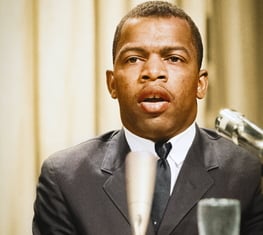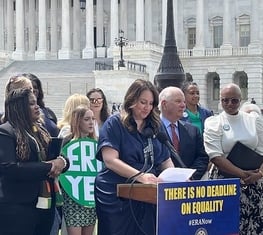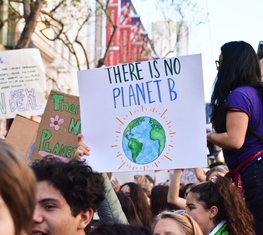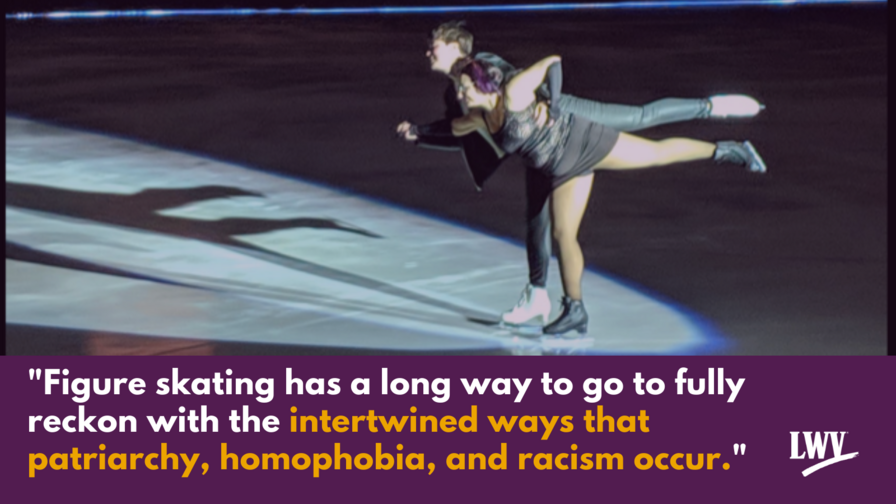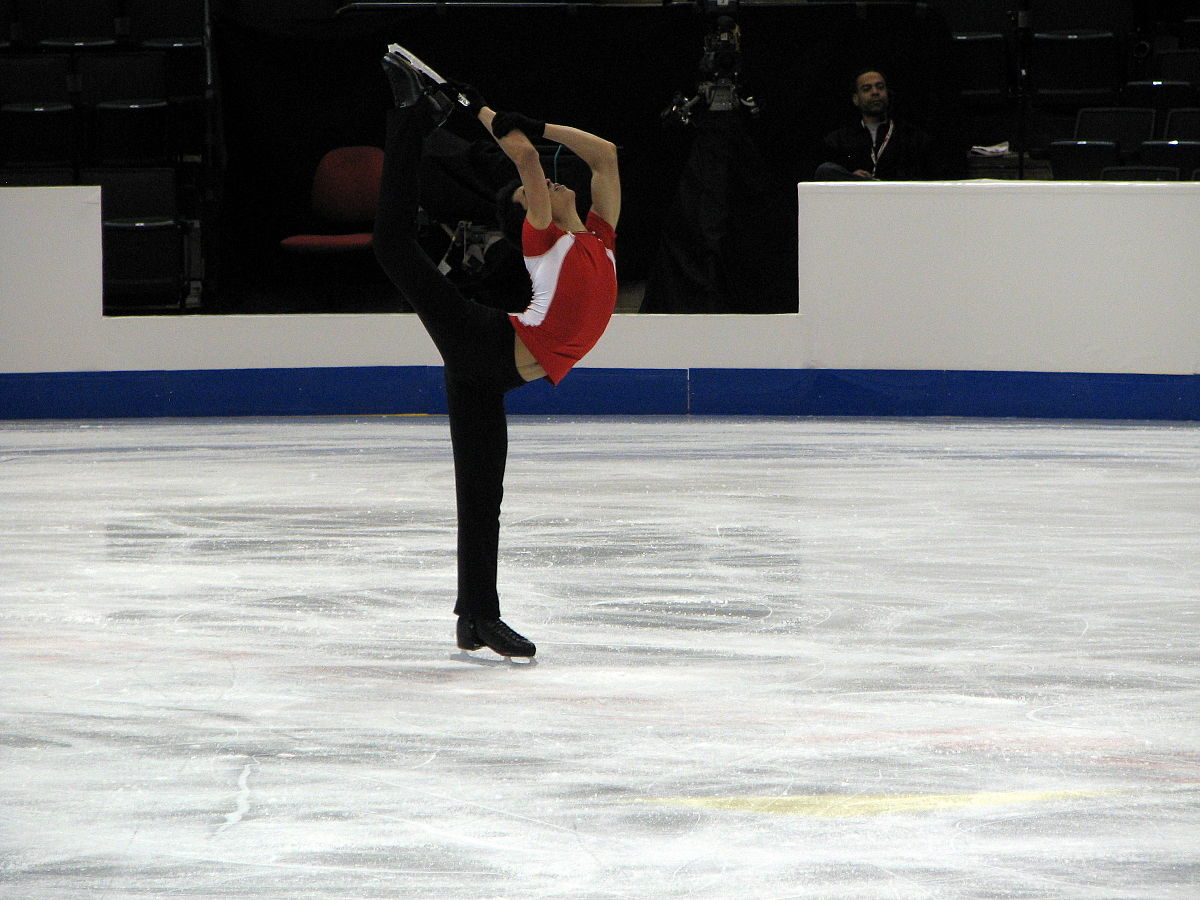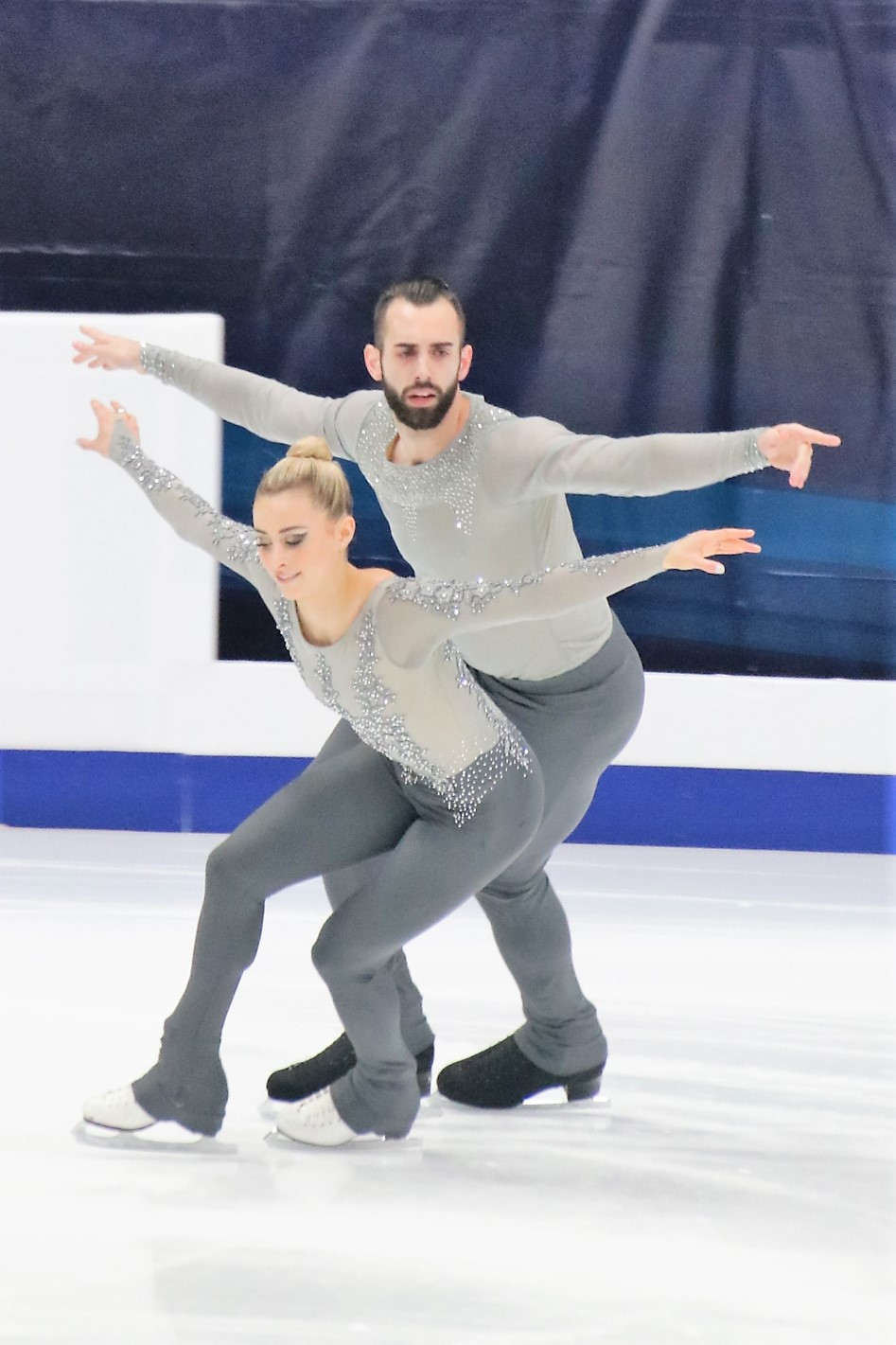Fighting for Equity On the Ice
This blog is written by Anna Kellar of the League of Women Voters of Maine, pictured above with skating partner Erica Rand.
I started figure skating as an adult at the same time that I started working full-time for the League. I went back to the sport I had loved as a child as an escape when I became frustrated with the world of politics.
When I am on the ice, I feel focused, creative, and like my body and mind are fully present and working together. Skating brings me so much joy, but I’ve also run up against the sport’s restrictive gender norms. I came to skating as an escape, yet in carving out my place in the sport I love, I’ve found another way to work toward justice and inclusion.
Figure skating has a long way to go to fully reckon with the intertwined ways that patriarchy, homophobia, and racism occur and the resulting harms done to athletes, from Olympic stars down to kids in the learn-to-skate program. It is a fiercely gendered sport, especially in pairs skating. That discipline divides skills into either a man’s role or a woman's role. Music choices, costumes, and choreography rarely stray from heteronormative romantic tropes, even when performed by siblings.
My pairs partner, Erica Rand, and I are challenging those binary gender norms. In doing so, we are also hoping to open up the sport we love to people of all genders and gender expressions.
About Us
A little bit about us: I’m a white, non-binary, trans person from Portland, Maine. I’m also the Executive Director of the League of Women Voters of Maine, a position I’ve held since late 2017.
Erica is a queer, cis, white woman who grew up in Chicago and has lived in Maine for several decades. She’s a professor of Gender and Sexuality Studies at Bates College and has written about her experiences as an adult figure skater in a book and several articles. She’s also a League member and has volunteered as an election observer with LWVME.
We met in the adult figure skating program in Portland and recognized each other as kindred spirits: skaters who are interested in social justice in the rink as well as the wider world. We each have competed individually at the US Adult National Championships in the Bronze category, which includes one-revolution jumps and single-position spins.
Battling Restrictive Gender Norms in Skating
In 2018, we started training together as a pairs team, thinking it would be fun to try a new discipline and skillset. Pairs skating requires performing side-by-side, synchronized versions of familiar elements, as well as elements new to us like throw jumps and lifts. Those pair elements all have two distinct roles - the lifter and the lifted, the thrower and the thrown. In the rulebook, those are referred to as the man’s role and the woman’s role respectively.
Right away, we were faced with choices: should we pick a role and stick with it? Should we each try to learn both parts? Initially, we and our coach tried both options. In fact, our first program had two throw waltz jumps — one where I threw Erica and one where she threw me. But we quickly learned that while our genders don’t prescribe one approach, physical size can. Being about 7 inches taller than Erica, it makes more sense for me to lift and throw her — play the “man’s role,” so to speak — most of the time.
Though COVID-19 interrupted our training, we are now working towards the Adult Bronze test, the first step toward us being able to compete as a pairs team. We still need to learn a few skills, but we know we can. At this point, it’s not the skills that stand in our way, but the gender limitations built into the rules. The US Figure Skating (USFS) rulebook says that any two people can make up a pair. However, to test, a pair must be a man and a woman (note that the rulebook does not account — here or anywhere — for the existence of non-binary people and others who do not identify as a man or a woman).
I was assigned female at birth, and that is the gender on my USFS membership card. According to that rule, Erica and I would not be allowed to test. And the rules say that pairs can only compete against other pairs of similar composition. (Why the discrepancy between the testing and competing rules, by the way? Erica thinks it was a carve-out meant to allow same-gender pairs to compete in the Gay Games without risking official sanction).
What would it mean to change the rule and allow Erica and I to compete in the humble Adult Bronze category? On the face of it, very little. We do the same elements as any other pair and would be judged by the same standards. In adult individual competitions, skaters are grouped by age, ability level (what the tests are for), and gender. In many competitions, if there are too few skaters in an age group, the groups might be combined to allow for more interesting competition and to save time. It’s possible the USFS officials we run into might take the same approach to us — recognize that there are no other pairs of the same gender composition as us and lump us in with the M/F (male/female) teams.
On the other hand, it’s not that uncommon to have a sole male competitor for his age and ability level at an adult competition, and I’ve never seen men and women’s competitions combined, except in the less-formal “showcase” events.
Again, figure skating is a deeply gendered sport. This is despite a large degree of parity in the actual moves done on the ice. Women (officially called “ladies” until June of this year) are generally expected to be ice princesses, displaying an aesthetic at the intersection of pageant queen and ballerina. They are pressured to be delicate, stay positive, and make the sport look effortless — and to not rock the boat in any way. Women of color face additional hurdles to accessing the sport’s model of acceptable femininity.
On the flipside, male skaters are praised for showing “masculine” programs (you would not believe the number of programs set to “It’s a Man’s World” in the last few years), being athletically aggressive, or even being straight — all to counteract the idea that figure skating is too artistic (read: too gay or feminine) to be a real sport.
Though there have been queer skaters from the start of the sport, homophobia is rampant at all levels. This past Pride month, three current or recently-retired Olympic skaters came out as LGBTQ+, and all said they had waited for years to be public about their sexuality, afraid that being true to themselves would harm them in the face of judges.
Pairs skating, with its sexist assumptions about skaters’ abilities (even a male/female pair wouldn’t allow the woman to be the one lifting and the man to be lifted), is full of heteronormative, and frankly old-fashioned storytelling, of strong men pursuing, rescuing, and supporting delicate women. The homophobia within and outside of the skating world means that there is a shortage of tall, masculine (i.e. straight or straight-presenting) men in the top levels of the discipline. Pair men are considered valuable. Pair women, on the whole, are treated as interchangeable. The men are forgiven many sins, while the women face pressure to remain thin, docile, and flawlessly feminine — or they can be replaced.
It’s a situation that exacerbates existing power disparities and facilitates abuse. Eating disorders, training through injury, and mental health problems are common, and just starting to be openly addressed within the community. Three recent public cases of sexual abuse involve crimes committed by male pair skaters (and covered up by their coaches).
All of this leaves Erica and me in the middle of an ongoing battle to be accepted as a pair in competitive skating.
The Bigger Picture: Gender Discrimination in Sports
We are not facing these challenges in a vacuum, but in the midst of a battle raging over the role of gender in sports. Watching the Olympics this summer, with the stories of athletic success and failure presented as a reflection of the hopes and fears of our nation, it’s clear that sports are political.
Laws against the participation of trans women and girls in school sports have become the latest weapon aimed against the LGBTQ+ community. Caster Semenya and other Black women athletes have been banned from Olympic competition as women due to their testosterone levels (an injustice that is both biologically unsound and redolent of racism). The US Women’s soccer stars’ inferior pay and the NCAA women’s basketball teams’ unequal equipment and facilities are just some of the ways women are still treated inequitably on the playing field — and mirror the continuing gender inequity and pay gaps across most/much of society. Whether it’s women playing football or men competing in artistic swimming, there are many athletes, recreational and elite, trying to bring down the remaining gendered barriers to participation.
Nonetheless, there are positive trends that make me hopeful that the future of the sport will be more inclusive than its present. At all levels of skating, more LGBTQ+ skaters and coaches are coming out, and allies are speaking up about the need to root out homophobia. Non-binary coach and professional skater Elliot Halverson hosted a series of Pride month conversations for USFS. The recent young adult novel Ana on the Edge focuses on a nonbinary skater. Initiatives like Diversify Ice and the Figure Skating Diversity and Inclusion Alliance are tackling racism and creating a community for skaters of color, including gender-nonconforming skaters.
And of course, organizations like the League are standing in support of women and LGBTQ+ athletes in cases like Hecox v. Little, which focuses on the right of transgender students to participate in school sports.
I especially enjoy cheering for the 2019 US Nationals pairs champions Ashley Cain-Gribble and Timothy Leduc, whose programs tell non-traditional stories about two strong partners working together. Leduc came out this year as non-binary and uses they/them pronouns. Because they compete as a man, with a female partner, Leduc has not run afoul of the rules.
In the broader world of sports, I am inspired by the strength of Black women athletes like Serena Williams, Naomi Osaka, and Simone Biles, who are braving sexism, racism, and mental health stigma and insisting that they are human beings first, athletes second. They help me believe that I too can compete in the sport I love as my full self.
When the culture of sports tells us that artistic equals feminine, and athletic equals male, it shuts down so many paths of expression and forces many skaters away from their authentic selves. Can’t we be artistic and athletic? Can’t we also have men portraying delicacy and women portraying strength? I dream about figure skating being a place where people of every race and every gender can compete to the best of their abilities and share their stories and identities with the world.
As Erica expressed in a recent article, “social-justice and anti-oppression work includes expanding access to pleasure and joy.” We hope that if we can win the opportunity to compete, our efforts will make a little more space for others to be their authentic selves.
The Latest from the League
The League of Women Voters is dedicated to ensuring equal rights and equal opportunity for all. This commitment led to LWVUS joining the legal challenge to Idaho’s Fairness in Women’s Sports Act which prohibits transgender women and girls, intersex persons, and any non-binary person from participating in sports.
The League joined other organizations on a letter voicing support for the Equality Act.
“While today’s decision is deeply disappointing for the LGBTQIA+ community, it is significant that the Court did not create a broad license to discriminate against same-sex couple’s ability to adopt."
Sign Up For Email
Keep up with the League. Receive emails to your inbox!
Donate to support our work
to empower voters and defend democracy.
